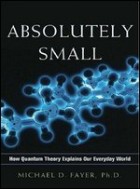Absolutely Small: How Quantum Theory Explains Our Everyday World
October 21, 2010
- author |
- Michael D. Fayer
- year published |
- 2010
Publishers Weekly | How a photon can be in two places at once is just one of the conundrums of quantum physics that Fayer (Elements of Quantum Mechanics) helps to unravel. The Stanford University Professor of Chemistry provides a roadmap for non-scientific readers who wish to understand the subject but lack advanced mathematical training.
Fayer’s belief that our everyday experiences “teach us to think in terms of classical physics” helps him easily breach the leap from playing ball to understanding how the earth orbits the sun. But because what we learn as children “prepares us to view nature in a manner that is fundamentally wrong,” most people are at a loss when probing seemingly simple questions: “Why are cherries red and blueberries blue?” While the large objects treated in classical physics can be measured without appreciable disturbance, the same is not true at the quantum level.
We may take the color and size of fruit for granted, but Fayer illustrates the ways in which “the natural world is driven by quantum phenomena” with a serious, accessible treatment of a complex and fascinating subject.
